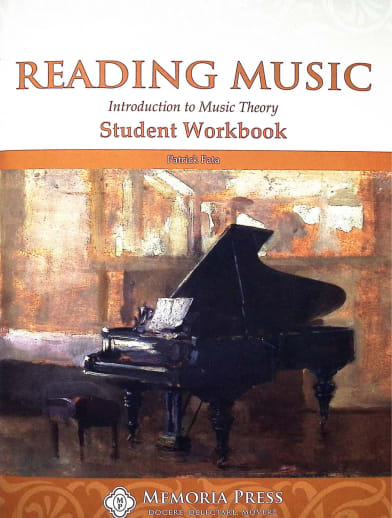This workbook contains theory exercises for practicing what was taught in the text. This will help a student make a connection to the new material with practice and review. Audio demonstrations are indicated in the student workbook and will aid in practicing perfectly! Answers to the workbook are found in the Reading Music: Intro to Music Theory Teacher Guide. Consumable, 89 pgs, pb. ~Amber
Reading Music: Introduction to Music Theory Workbook | Memoria Press
Description
Reading Music: Introduction to Music Theory introduces the concepts of rhythm, meter, and musical notation in short lessons that will bridge to further musical study or music theory. The program uses the Kodaly syllable system of learning rhythm. In this method, note values are assigned specific syllables that express their durations. Reading Music: Intro to Music Theory is organized in twelve units, each consisting of four lessons. There are a total of 60 lessons that include 48 lessons of instruction and practice plus 12 test days. This would be a ½ credit course for music or serve as an elective.
In the Student Text, a small amount of new information is
introduced in each lesson and is reviewed multiple times to ensure mastery. The
twelve units will cover rhythm, staff, clefs, notes, ties and rests, ledger
lines, and other musical elements. The Student Workbook contains
theory exercises for practicing what was taught in the text. This will help a
student make a connection to the new material with practice and review. Audio
demonstrations are indicated in the student workbook and will aid in practicing
perfectly! The Teacher Guide is identical to the student
workbook with answers inserted, printable tests, and tests with answers.
The Audio is a valuable option to help those who are studying
independently or for teachers who may not be familiar with the Kodaly syllable
system of learning rhythm. Short audio demonstration clips of all concepts will
help students learn rhythm the right way. In the Student Workbook and Teacher
Guide, an audio symbol will indicate when there is a clip to listen to. An
email will be sent with a code to use on the Memoria Press website for forever
access to the stream.
This course is suitable for all ages. Younger students would benefit from a slower pace of one lesson per week, while older students could do a lesson per day or move at their pace. This could be used in a classroom or even in private lessons. A very thorough introduction into staff, note names, rests and note values, and rhythm. ~Amber
| Product Format: | Paperback |
|---|---|
| Grades: | 2-12 |
| Brand: | Memoria Press |
| ISBN: | 9781547705665 |
| Length in Inches: | 11 |
| Width in Inches: | 8.5 |
| Height in Inches: | 0.25 |
| Weight in Pounds: | 0.6 |

